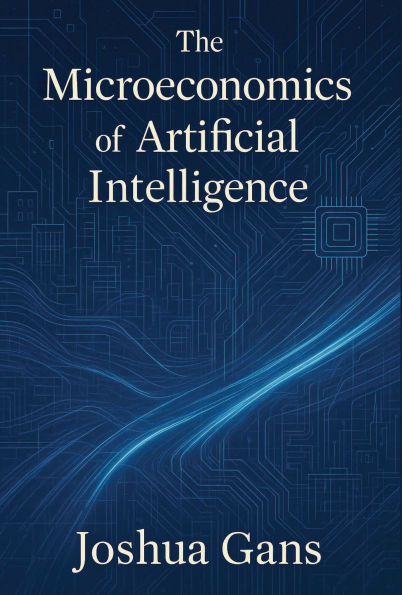A comprehensive treatment of the microeconomics associated with the adoption and use of artificial intelligence.
It is well-recognized that recent advances in AI are exclusively advances in statistical techniques for prediction. While this may facilitate automation, this result is secondary to AI’s impact on decision-making. From an economics perspective, predictions have their first-order impacts on the efficiency of decision-making.
In The Microeconomics of Artificial Intelligence, Joshua Gans examines AI as prediction that enhances and perhaps enables decision-making, focusing on the impacts that arise within firms or industries rather than broad economy-wide impacts on employment and productivity. He analyzes what the supply and production characteristics of AI are and what the drivers of the demand for AI prediction are. Putting these together, he explores how supply and demand conditions lead to a price for predictions and how this price is shaped by market structure. Finally, from a microeconomics perspective, he explores the key policy trade-offs for antitrust, privacy, and other regulations.
1147114370
It is well-recognized that recent advances in AI are exclusively advances in statistical techniques for prediction. While this may facilitate automation, this result is secondary to AI’s impact on decision-making. From an economics perspective, predictions have their first-order impacts on the efficiency of decision-making.
In The Microeconomics of Artificial Intelligence, Joshua Gans examines AI as prediction that enhances and perhaps enables decision-making, focusing on the impacts that arise within firms or industries rather than broad economy-wide impacts on employment and productivity. He analyzes what the supply and production characteristics of AI are and what the drivers of the demand for AI prediction are. Putting these together, he explores how supply and demand conditions lead to a price for predictions and how this price is shaped by market structure. Finally, from a microeconomics perspective, he explores the key policy trade-offs for antitrust, privacy, and other regulations.
The Microeconomics of Artificial Intelligence
A comprehensive treatment of the microeconomics associated with the adoption and use of artificial intelligence.
It is well-recognized that recent advances in AI are exclusively advances in statistical techniques for prediction. While this may facilitate automation, this result is secondary to AI’s impact on decision-making. From an economics perspective, predictions have their first-order impacts on the efficiency of decision-making.
In The Microeconomics of Artificial Intelligence, Joshua Gans examines AI as prediction that enhances and perhaps enables decision-making, focusing on the impacts that arise within firms or industries rather than broad economy-wide impacts on employment and productivity. He analyzes what the supply and production characteristics of AI are and what the drivers of the demand for AI prediction are. Putting these together, he explores how supply and demand conditions lead to a price for predictions and how this price is shaped by market structure. Finally, from a microeconomics perspective, he explores the key policy trade-offs for antitrust, privacy, and other regulations.
It is well-recognized that recent advances in AI are exclusively advances in statistical techniques for prediction. While this may facilitate automation, this result is secondary to AI’s impact on decision-making. From an economics perspective, predictions have their first-order impacts on the efficiency of decision-making.
In The Microeconomics of Artificial Intelligence, Joshua Gans examines AI as prediction that enhances and perhaps enables decision-making, focusing on the impacts that arise within firms or industries rather than broad economy-wide impacts on employment and productivity. He analyzes what the supply and production characteristics of AI are and what the drivers of the demand for AI prediction are. Putting these together, he explores how supply and demand conditions lead to a price for predictions and how this price is shaped by market structure. Finally, from a microeconomics perspective, he explores the key policy trade-offs for antitrust, privacy, and other regulations.
99.99
Pre Order
5
1

The Microeconomics of Artificial Intelligence
434
The Microeconomics of Artificial Intelligence
434Related collections and offers
99.99
Pre Order

Product Details
| ISBN-13: | 9780262384971 |
|---|---|
| Publisher: | MIT Press |
| Publication date: | 12/09/2025 |
| Sold by: | Penguin Random House Publisher Services |
| Format: | eBook |
| Pages: | 434 |
About the Author
From the B&N Reads Blog
